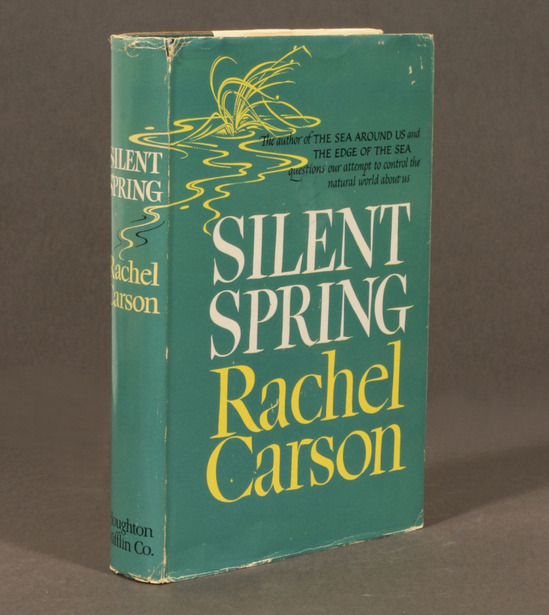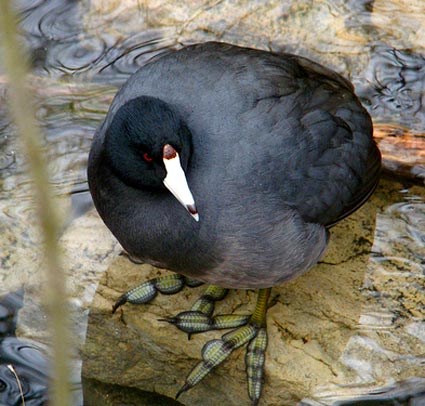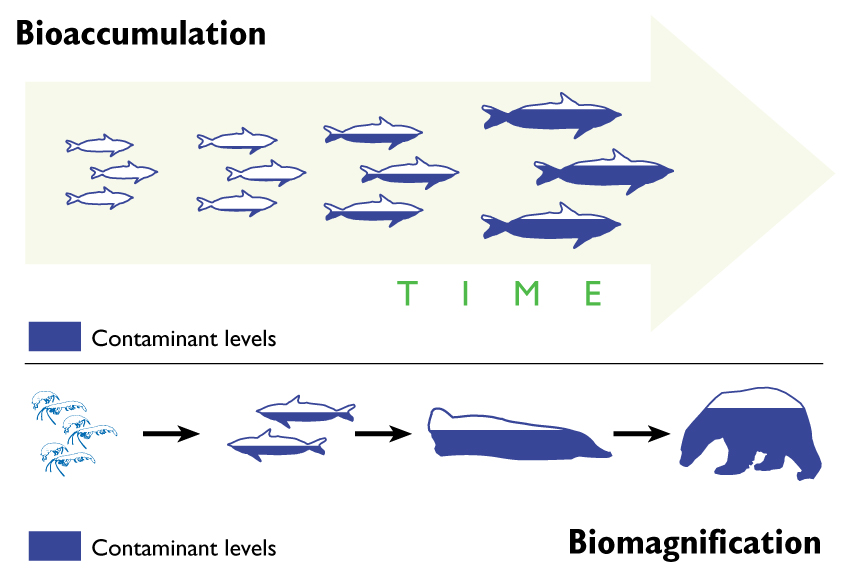 In 1962 Rachel Carson published what is now recognized as one of the most important books in conservation literature, Silent Spring. Based on original research conducted in response to reports linking an observed decline in bird populations with widespread use of DDT as a pesticide in the 1950’s, the book broadly asserted that liberal use of DDT was contributing to considerable detrimental impact on the environment through trophic interactions. Although the book was met with considerable opposition from the chemical industry and lobbyists at the time, the academic community, along with the general public, defended the work. The book also emboldened the environmentalist movement, and eventually resulted in a ban on DDT in 1972, following president Nixon’s creation of the Environmental Protection Agency (EPA).
In 1962 Rachel Carson published what is now recognized as one of the most important books in conservation literature, Silent Spring. Based on original research conducted in response to reports linking an observed decline in bird populations with widespread use of DDT as a pesticide in the 1950’s, the book broadly asserted that liberal use of DDT was contributing to considerable detrimental impact on the environment through trophic interactions. Although the book was met with considerable opposition from the chemical industry and lobbyists at the time, the academic community, along with the general public, defended the work. The book also emboldened the environmentalist movement, and eventually resulted in a ban on DDT in 1972, following president Nixon’s creation of the Environmental Protection Agency (EPA).
Bioaccumulation is a phenomenon that occurs when chemicals or toxins build in the tissues of organisms over time. One of the key problems with DDT is that at low concentrations it appeared to be harmless to vertebrate organisms, while being lethal to common pest invertebrates such as mosquitoes and flies. Thus, the negative effects of DDT on larger organisms such as mammals and birds were not initially apparent. DDT is not easily broken down through the metabolic pathway, yet readily passes across the gastrointestinal barrier. Organisms that consume organic material containing DDT will therefore accumulate the chemical in their fat stores, until eventually concentrations become lethal. However, such compounds can also be “passed up” the food chain in a process known as biomagnification. Insects such as mosquitoes that die from DDT exposure may find their way into water, where they are consumed by fish. Those fish then sequester the chemical in their tissues, and may then be consumed by larger predators such as eagles, osprey and falcons (Carson, 1962).
Although DDT has been banned for use in the U.S. except for in emergency situations, there are a number of other chemicals and compounds that have been known to bioaccumulate and biomagnify. Heavy metals such as mercury (Hg) are highly toxic to most living organisms. In particular, mercury causes permanent damage to a class of molecules called thioredoxin reductases (Carvalho, et. al., 2008), enzymes that are essential for proper cell growth and in counteracting oxidative damage from metabolic activity (Linster & Van Schaftingen, 2007). In an ecosystem-level study in Connecticut, it was shown that increases in mercury concentrations of fish were correlated with body size and age. Additionally, predators occupying the top of the food chain accumulated mercury the fastest, regardless of species identity (Neumann & Ward, 1999). Similar patterns of bioaccumulation and biomagnification have been observed in sharks in marine ecosystems (Maz-Corrau, et al., 2012), as well as montane stream ecosystems (Chasar, et al., 2009).
 However, bioaccumulation of pollutants in aquatic ecosystems may have potentially devastating consequences for non-aquatic organisms as well. In particular, fish-eating sea birds are very susceptible to poisoning from industrial pollutants, as some compounds such as polychlorinated biphenyls (PCBs) are remarkably persistent in tissues (Walker, 1990). In a study conducted at Kesterson Reservoir in California, bioaccumulation of selenium (Se) was observed in several species of birds, and correlated with reductions in adult body weight, and embryonic mortality (Ohlendorf, et al., 1990).
However, bioaccumulation of pollutants in aquatic ecosystems may have potentially devastating consequences for non-aquatic organisms as well. In particular, fish-eating sea birds are very susceptible to poisoning from industrial pollutants, as some compounds such as polychlorinated biphenyls (PCBs) are remarkably persistent in tissues (Walker, 1990). In a study conducted at Kesterson Reservoir in California, bioaccumulation of selenium (Se) was observed in several species of birds, and correlated with reductions in adult body weight, and embryonic mortality (Ohlendorf, et al., 1990).
But bioaccumulation doesn’t just stop at birds and fish. Contamination of fisheries with metabolically stable compounds and chemicals has been reported across the globe, from Romania (Bravo, et. al., 2010) to China (Feng, et al., 2007). Even in the United States there is mounting concern that deposition of atmospheric heavy metals from industrial manufacturing and coal-fired power plants can reach fisheries via hydrologic processes such as runoff, and eventually affect human health (Driscoll, et al., 2007). After all, humankind has in many ways found its way to the top of the global food chain. So while the effects of bioaccumulation may seem a distant or alien concern in our isolated human ecosystem, it may not be long before heavy metals make their way onto our dinner plate.
Sources:
Bravo, A. G., Loizeau, J. L., Bouchet, S., Richard, A., Rubin, J. F., Ungureanu, V. G., … & Dominik, J. (2010). Mercury human exposure through fish consumption in a reservoir contaminated by a chlor-alkali plant: Babeni reservoir (Romania). Environmental Science and Pollution Research, 17(8), 1422-1432.
Carson, R. (1962). Silent spring. Houghton Mifflin Harcourt.
Carvalho CM, Chew EH, Hashemy SI, Lu J, Holmgren A (2008). “Inhibition of the human thioredoxin system: A molecular mechanism of mercury toxicity.”. Journal of Biological Chemistry. 283 (18): 11913–11923.
Chasar, L. C., Scudder, B. C., Stewart, A. R., Bell, A. H., & Aiken, G. R. (2009). Mercury cycling in stream ecosystems. 3. Trophic dynamics and methylmercury bioaccumulation. Environmental science & technology, 43(8), 2733-2739.
Driscoll, C. T., Han, Y. J., Chen, C. Y., Evers, D. C., Lambert, K. F., Holsen, T. M., … & Munson, R. K. (2007). Mercury contamination in forest and freshwater ecosystems in the northeastern United States. BioScience, 57(1), 17-28.
Feng, X., Li, P., Qiu, G., Wang, S., Li, G., Shang, L., … & Fu, X. (2007). Human exposure to methylmercury through rice intake in mercury mining areas, guizhou province, china. Environmental science & technology, 42(1), 326-332.
Linster, C.L.; Van Schaftingen, E. (2007). “Vitamin C: Biosynthesis, recycling and degradation in mammals.”. FEBS Journal. 274 (1): 1–22.
Maz-Courrau, A., López-Vera, C., Galvan-Magaña, F., Escobar-Sánchez, O., Rosíles-Martínez, R., & Sanjuán-Muñoz, A. (2012). Bioaccumulation and biomagnification of total mercury in four exploited shark species in the Baja California Peninsula, Mexico. Bulletin of Environmental Contamination and Toxicology, 88(2), 129-134.
Neumann, R. M., & Ward, S. M. (1999). Bioaccumulation and biomagnification of mercury in two warmwater fish communities. Journal of Freshwater Ecology, 14(4), 487-497.
Ohlendorf, H. M., Hothem, R. L., Bunck, C. M., & Marois, K. C. (1990). Bioaccumulation of selenium in birds at Kesterson Reservoir, California. Archives of Environmental Contamination and Toxicology, 19(4), 495-507.
Walker, C. H. (1990). Persistent pollutants in fish-eating sea birds—bioaccumulation, metabolism and effects. Aquatic Toxicology, 17(4), 293-324.
Images (In Order of Appearance):
1st edition copy of Rachel Carson’s Silent Spring. (https://thebreakthrough.org/archive/silent_spring_environmentalism_and_fear)
Illustration of the process of bioaccumulation and biomagnification. World Wildlife Fund. (http://sustainable-nano.com/2013/12/17/the-cautionary-tale-of-ddt-biomagnification-bioaccumulation-and-research-motivation/)
American Coot, one of the many species detrimentally impacted by bioaccumulation of selenium (https://www.allaboutbirds.org/guide/American_Coot/id)
Coal fired power plant. Shutterstock. (https://thinkprogress.org/7-out-of-10-americans-want-their-states-to-comply-with-the-epas-climate-plan-8ad8f9fe8e74)




